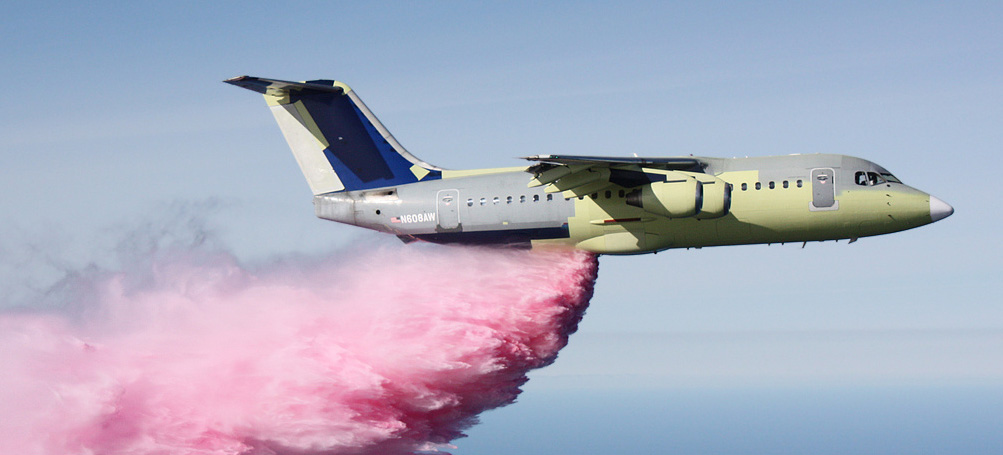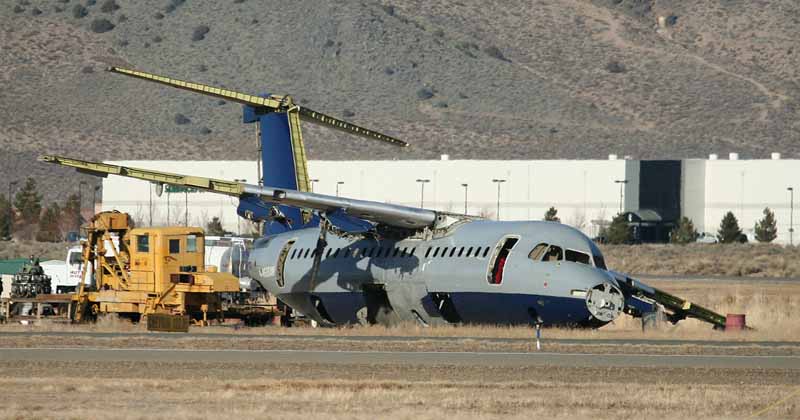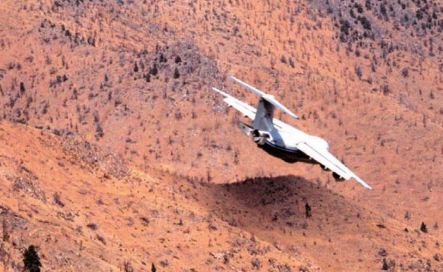
I’m not sure how we missed this before, but on October 28, 2009 the BAe-146-200 that is being converted to an air tanker by Tronos made its first drop over Prince Edward Island in Canada. According to the company “The aircraft performed flawlessly as did the tank and delivery system.”
Here are some stats about the aircraft, taken from the Tronos web site:
- Water / retardant capacity: 3,000 USG
- Range: 2,700km / 1,200 nm
- Turn-around time: 8 minutes
- Typical drop speed / altitude: 120 knots (138 mph) @ 150 feet (200km/h (124 mph) @ 46 meters)
- Cruise speed: 330 knots (600 km/h) (380 mph)
- Fast fill / Variable flow delivery system
- Short take-off length and steep field approach
- Air-brake / flap combination: improves low speed maneouvrability
The aircraft Tronos is converting is number N608AW, serial number E2049, manufactured in 1986.
UPDATE:
In a comment, Ken mentioned the fact that Minden Air, at Minden, Nevada, is also converting a BAe 146-200 into an air tanker. In 2004 and 2005 Minden and Tronos were talking about working together to convert a BAe-146-200 into an air tanker, but that project fizzled out. Minden acquired one, number N606AW, serial number 2033, but now it has been turned into scrap at Minden.

The company did some low-level flight testing in 2004 with a BAe 146-200, flying a total of nine sorties with the aircraft configured much like an air tanker.

But in January, 2009 Minden acquired another BAe-146-200, number N446MA, serial number E2111, manufactured in 1989. Minden intends to have this aircraft converted into an air tanker for the 2010 fire season. Some of the approvals they will have to get include a Supplemental Type Certificate from the FAA, and certification from the Interagency Air Tanker Board. BAE Systems, the manufacturer of the aircraft, is consulting with Minden, and will stand by any design and technical contributions they are asked to make. BAE Systems hopes the conversion will be successful so that a new market for their aircraft can be created.
Here are a couple of interesting facts about the BAe-146.
- In spite of the fact that it has four turbofan engines, it is one of the quietest jet airliners, producing only 80 decibels when taking off. This meant that in the 1980’s and 1990’s, before other manufacturers reduced the noise from their aircraft, the BAe-146 could land and takeoff at noise-restricted airports when others could not, or at certain times, such as late at night, when others couldn’t.
- Some of the earliest BAe-146’s had problems with the engines, resulting in the joke that BAe stood for “Bring Another engine”.

Here is a link to a page that lists other articles we have written that mention the BAe 146. The numbers at the end of each article’s title refer to the number of comments our readers left.
https://wildfiretoday.com/?s=bae+146
I worked on the 146 conversion in summerside. It was a lot of fun. I hope to be involved in many more
Hello Chris,
Would it be possible for you to contact me at colin.frost at btinternet.com please.
I am a BAe 146 historian.
Many thanks,
Colin
I was at Hatfield the day the 146 was born. I’d been working on the HS144 doing engine installation studies which kept me busy because we couldn’t decide whether it should have 2, 3 or 4 engines! The 4-engine version looked very much like a slightly stretched 146 with a smaller tail. The Chief Aerodynamicist “Tommy” Thomason called a meeting and announced that HS was launching a RTOL version of the 144 to be called HS146. The reason was governmental support for an aircraft suitable for inner-city airport operations. This may have been around 1971-2 according to my memory. We went full speed for a couple of years. I did the nacelle design for the ALF-502’s (caused some redesign at Lycoming – they had done mostly helicopter engines up to that point – we were their launch customer for the turbofan). A few years later the project was shelved because of the global recession.
My offices faces Runway 29 at KMSO (Missoula) today I got a few pictures of Neptune’s Tanker 40 (BAe-146) doing some low approaches and a retardant drop over the runway…my guess is it’s still not certified by the USFS as we have a fire about 40 miles south of Missoula and they have been using P2V and P3 tankers.
Contact me if you want the pictures
bill@hallusa.net…I would post them if I knew how on this site.
Mr. Moss got in touch with us, and his photos are here:
https://wildfiretoday.com/2010/07/27/photos-of-the-new-jet-powered-air-tanker/
Thanks!
Good day Bill,
I have been watching with interest the development of the BAE146 into an air tanker and I was very interested in your pictures of Neptune’s Tanker 40 (BAe-146) taken last July during the initial drop tests.
Can you confirm if these tests are still continuing at Missoula and whether the aircraft is still there, or have they moved on please.
I look forward to hearing from you.
Kind regards,
Colin
Thats actually me flying the first drop in N608AW in Summerside. I also did most of the test flights to date.
You`re a lucky guy.
Couple of questions for you – much trim change during the drop? It looks like Flap 18 with some airbrake,I guess the gear warning is inhibited ? I have 8000hrs plus on the 146 / Avro RJ so that is why I`m curious. I hope it works out, good to see it doing something way more useful than just taking pax. from A to B.
T-46 is currently at Minden-Tahoe. It’s N446MA. Not sure when he’ll be called out again.
Thanks Kepler.
T-40 is still on the ramp at Neptune this morning, 7 Jun at 0617 MDT
I’m not sure. The paperwork we got at the end of last season was for T-46, I was unaware of more then one BAe 146 until I came upon this site. I was just looking too see if I could find any info on where the loading valve was and if it had a light system or gauge in case it showed up and we had to load.
Tomorrow I’ll hop on AFF and find out which one it is and the N-number then come back and post. Also may try and call another ATB manager down there and see if I can get any info on how it’s doing for you guys.
I got word today that the new tanker is in the south working on some fires there already. I didn’t get around to hopping on flight following to see if I could find her, but I will tomorrow. I’ve already been assured that she’ll come to my tanker base at some point this season so we can do a walk though.
Which tanker? Minden’s or Neptune’s? And, do you know the N-number for Minden’s?
Here is a photo of Neptune’s.
https://wildfiretoday.com/2010/05/26/a-new-air-tanker/
Its good to see 608 back flying again. She was a great plane to work on as all of the BAe146’s were.Keep her flying, Thanks
Flew into MSO last Friday and saw a BAE 146, painted in Neptune Aviation colors sitting on their ramp with a big 40 on the tail.
Craig,
That is the Tronos conversion ex N608AW now registered N146FF which flew into MSO on 15th May. We assume that it is still awaiting certification before starting to crew train.
Matt,
I reckon you were in Victorville.
Any chance of a photo of N446MA in
its new colours please.
It is presently in Bishop and due back at Minden today
colin i was unable to get any photos. i did find out the that minden bird is not tanked yet its just a shell right now. it is all white at this time.
today i Minden’s 146 and she looks like she will be the next generation of airtankers. wont reveal where i saw her but the tanker base as a runway thats 7201 x 150 ft.
Matt-
Pretty foxy of you to leave a clue like that.
I tried to get more information from Menden a week ago about their conversion project, but they are not returning phone calls.
The comment regarding the 146 engines is long out of date.The engines are now pretty much on condition as a result of the investment over the years and easily make 7500 cycles before removal.
The same basic engine is in the chinnook helicopter,Challenger aircraft and the abrahams main battle tank!
This engine variant (ALF502) did have issues though. In certain flight conditions (alt, icing, temp). The exit guide vanes after the LP compressor (supercharger) would ice up and choke the engine causing rollback. There is a fix to this or an altitude limit, and other engines, such as the LF507, have a 2 stage LP compressor. The additional stage causes a greater temp increase, so no ice. None of this is of consequence to the fire fighting community as you’re both low and hot.
Both medium and heavy jets produce air turbulence that in time will sink downward.This results in time seperation for light aricraft using the same runway after a heavy or medium has landed or taken off at an airport. I wonder how this would effect a fire after a drop and if it is counter productive?
I’m thinking, and this is just a wild-ass guess from a ground-pounder, that all aircraft produce wingtip vortices, which become wake turbulence. Heavier aircraft have a larger wing surface area, disturbing more air, resulting in more pronounced and severe wake turbulence. So if a BAe-146 carrying 3,000 gallons weighs about the same as other Type 1 air tankers, it may have a similar degree of wake turbulence as a P3, C-130, or DC-7.
The smaller the following aircraft, the more it would be susceptible to problems caused by the wake turbulence. A Single Engine Air Tanker or lead plane following a 747, Martin Mars, or DC-10 air tanker would most likely want to stay pretty far behind those Very Large critters.
Are there any pilots out there that can add to, or correct, my lame-ass guesses?
Bill,
Your guesses are pretty much right on, not lame at all. The size of an aircraft’s wake turbulence is predicated on the wing design, weight, speed, and configuration. Generally speaking, the heavier and slower the aircraft is, the larger the wake. Also, when an aircraft has flaps extended, as they do during retardant drops, there is a larger wake.
B. Morgan,
While an aircraft’s wake turbulence isn’t desirable, it’s effect is rarely of any consequence. There are two reasons for this: 1.) Tankers typically drop from 150′ above the canopy, so most of the force of the turbulence generated from the aircraft’s wake is dissipated before ever fanning the flames. 2.) Airtankers’ drops are often used to build line in front of an advancing fire, i.e. they are not overflying the flame directly. Helicopters- especially hovering ones- are another story.
I’m a pilot with 5 years experience in aerial wildland firefighting.
Bill,
Know that Tronos has demonstrated the BAe-146 as an airtanker platform, have you or anyone heard about the BAe-146 that Minden Air has been working on for the last several years?
Thanks Ken. I updated the article to include information about Minden’s conversion.